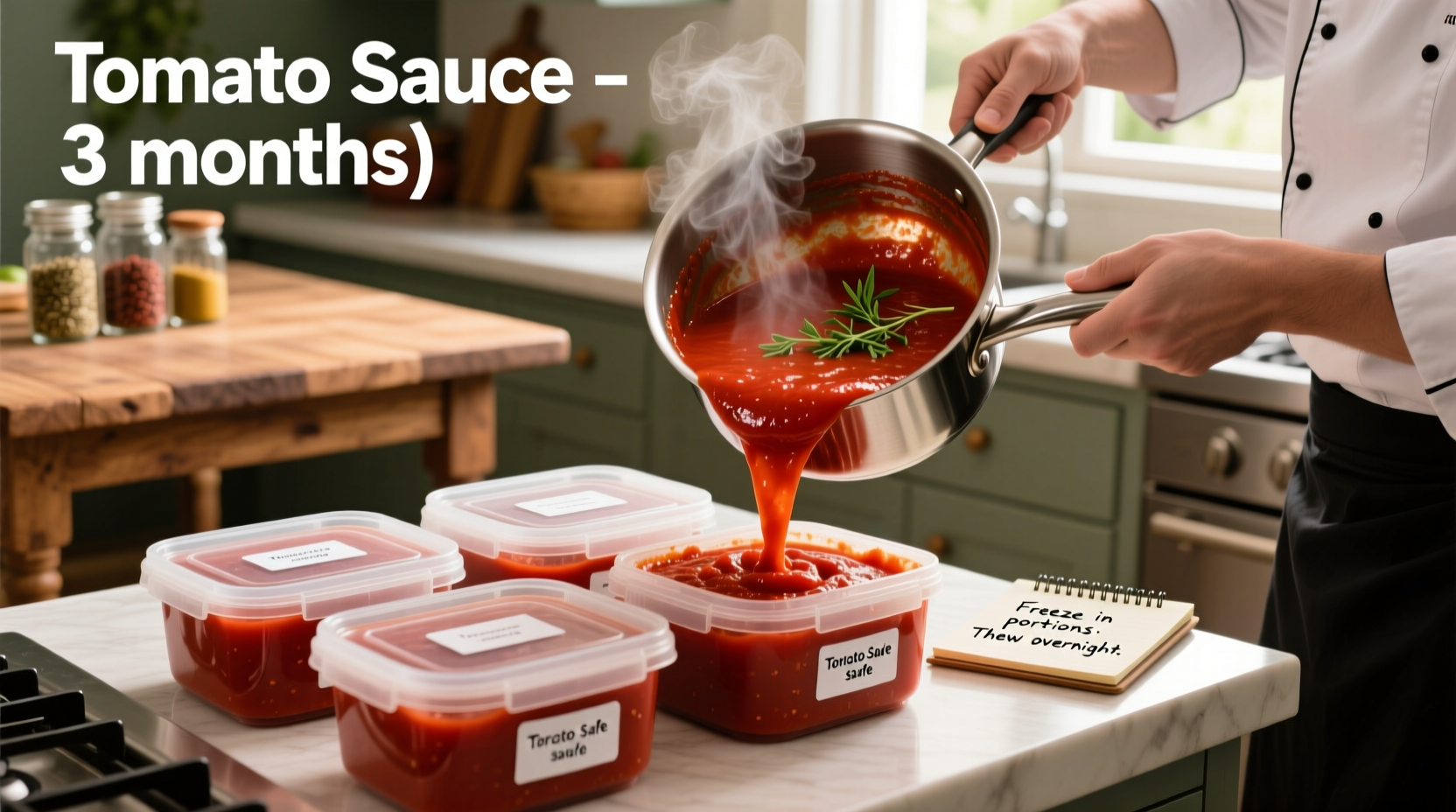Freeze tomato sauce properly by cooling it completely, using airtight containers with 1-inch headspace, and labeling with dates. Properly frozen tomato sauce maintains best quality for 6-8 months at 0°F (-18°C) while remaining safe indefinitely when stored correctly.
Why Freezing Tomato Sauce Matters for Home Cooks
Preserving your homemade tomato sauce through freezing isn't just convenient—it's a food waste solution that saves both money and time. According to the USDA Food Safety and Inspection Service, proper freezing maintains nutritional value while preventing spoilage. When you freeze tomato sauce correctly, you preserve the fresh flavor of summer tomatoes for year-round enjoyment without artificial preservatives.
Before You Start: Essential Preparation Checklist
Successful freezing begins long before your sauce touches the freezer. Follow these preparation steps to ensure optimal results:
- Cool your sauce completely—never freeze hot or warm sauce (this creates ice crystals and compromises texture)
- Use quality containers designed for freezing (glass jars with straight sides, BPA-free plastic containers, or heavy-duty freezer bags)
- Leave proper headspace—1 inch for containers, ½ inch for bags to allow for expansion
- Acidify if needed—for low-acid tomato varieties, add 1 tablespoon lemon juice per pint for safety

Step-by-Step Freezing Process for Perfect Results
Follow this professional chef-tested method to freeze tomato sauce without compromising flavor or texture:
Step 1: Rapid Cooling Technique
Transfer hot sauce to a clean stainless steel bowl and place in an ice bath, stirring occasionally. Cool to room temperature within 2 hours (critical food safety window per FDA guidelines). Never skip this step—slow cooling promotes bacterial growth.
Step 2: Portion Control for Practical Use
Divide sauce into recipe-sized portions using these professional measurements:
| Recipe Need | Recommended Portion | Container Type |
|---|---|---|
| Pasta sauce (2 servings) | 1½ cups | 4oz freezer bag |
| Pizza sauce (12" pizza) | ¾ cup | Silicone ice cube tray |
| Stew base (4 servings) | 2 cups | 8oz glass jar |
| Batch cooking | 4 cups | Quart container |
Step 3: Container Selection Guide
Choose containers based on your usage patterns:
- Freezer bags: Lay flat for space efficiency; ideal for portioned sauce
- Glass jars: Use straight-sided mason jars (never shoulder jars—risk of breakage)
- Silicone trays: Freeze in cubes then transfer to bags for flexible portioning
- Rigid containers: Best for long-term storage (up to 12 months)
Step 4: Proper Labeling System
Use waterproof labels with this critical information:
- Date of freezing (most important for quality tracking)
- Sauce type ("Marinara," "Arrabbiata," etc.)
- Portion size
- Special ingredients ("with mushrooms," "no salt added")
Freezer Storage Timeline and Quality Boundaries
Understanding the practical limits of frozen tomato sauce prevents wasted effort and ensures quality. The National Center for Home Food Preservation provides these evidence-based guidelines:
- Optimal quality window: 6-8 months at 0°F (-18°C)
- Absolute maximum: 12 months (quality degrades noticeably after 8 months)
- Temperature critical point: Below 0°F (-18°C) prevents ice crystal formation
- Freezer burn threshold: Occurs when temperature fluctuates above 0°F
Important context boundaries: Freezing doesn't improve quality—it preserves current quality. Sauce that tasted mediocre before freezing won't improve. Also, tomato-based sauces with dairy or meat should be consumed within 2-3 months due to faster quality degradation.
Thawing and Using Frozen Tomato Sauce Properly
How you thaw frozen sauce significantly impacts final texture and flavor. Follow these professional methods:
Safe Thawing Methods
- Refrigerator method: Transfer container to fridge 24-48 hours before use (best for quality)
- Cold water method: Submerge sealed bag in cold water, changing water every 30 minutes
- Direct cooking: Add frozen sauce cubes directly to simmering dishes (ideal for soups/stews)
What Not to Do
- Never thaw at room temperature (creates food safety risks)
- Avoid microwave thawing (creates uneven heating and texture issues)
- Don't refreeze previously thawed sauce (quality and safety concern)
Troubleshooting Common Freezing Issues
Even with proper technique, problems can occur. Here's how to fix them:
Separation Issues
Problem: Oil separates from tomato solids after thawing
Solution: Stir vigorously while gently reheating; add 1 tsp cornstarch slurry if separation persists
Texture Problems
Problem: Sauce becomes watery after thawing
Solution: Simmer uncovered for 5-10 minutes to reduce excess liquid; add tomato paste for body
Flavor Changes
Problem: Flavor seems muted after freezing
Solution: Brighten with fresh basil, a splash of balsamic vinegar, or grated Parmesan during reheating
Maximizing Your Frozen Sauce Experience
Professional chefs use these advanced techniques to get the most from frozen tomato sauce:
- Freeze sauce in recipe-ready portions—measure exactly what you need for your favorite dishes
- Create flavor boosters—freeze herb-infused oil separately to add fresh flavor when reheating
- Use the ice cube tray method for precise small portions (1 cube = 2 tablespoons)
- Rotate your stock using the FIFO method (First In, First Out) to minimize waste
Remember that properly frozen tomato sauce maintains safety indefinitely when kept at 0°F, but quality peaks within 6-8 months. The USDA Food Safety and Inspection Service confirms that frozen foods remain safe as long as the freezer maintains proper temperature, though quality gradually declines over time.











 浙公网安备
33010002000092号
浙公网安备
33010002000092号 浙B2-20120091-4
浙B2-20120091-4